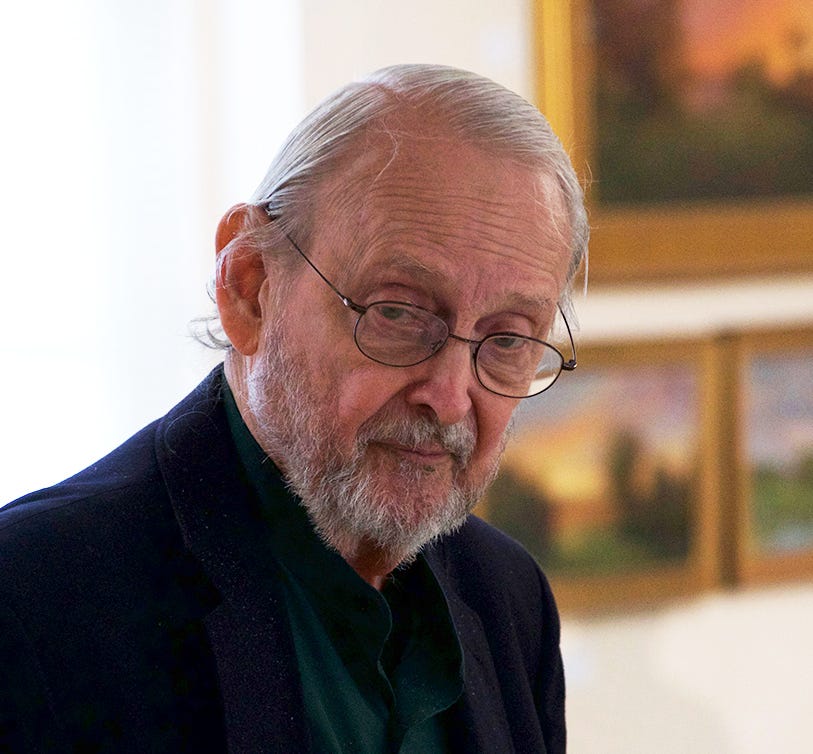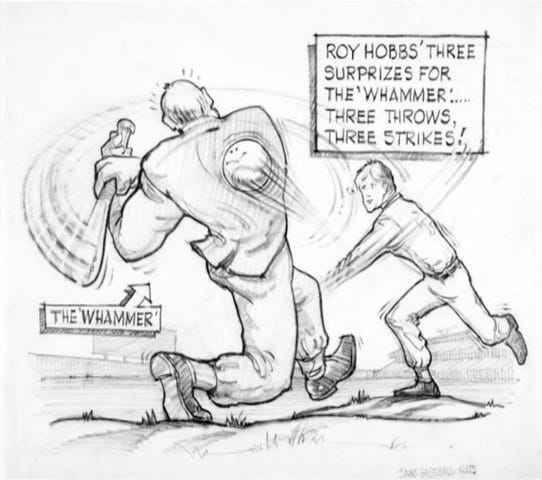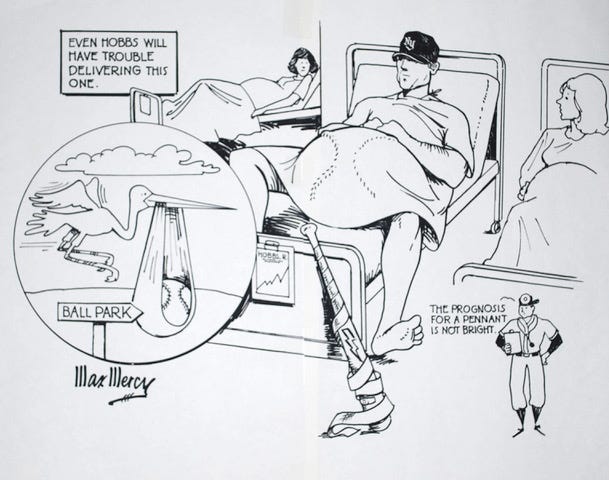IBWAA members love to write about baseball. So much so, we've decided to create our own newsletter about it! Subscribe to Here's the Pitch to expand your love of baseball, discover new voices, and support independent writing. Original content six days a week, straight to your inbox and straight from the hearts of baseball fans.
Pregame Pepper
Did you know…
One reason Sirius XM’s Phlash Phelps [‘60s Channel morning man] loves baseball is his heritage: dad Wil Phelps was a minor-league shortstop in the system of the old Philadelphia Athletics during the ‘50s and ‘60s . . .
Records remain: no league has scored more than 13 runs in an All-Star Game and no game has produced more than 21 runs . . .
Fred Lynn still owns the only grand-slam in All-Star history, while Ichiro owns the only inside-the-park home run . . .
Hank Aaron played every inning of eight different All-Star games but started another eight All-Star games on the bench . . .
Even the mascot of the hated Houston Astros [see 2017 World Series] was booed at the All-Star Game.
Leading Off
Venerable Baseball Artist Has Variety of Subjects
By Noel P. Roby
[Editor’s Note: This is the second part of a lengthy essay on a great baseball illustrator.]
I was over-the-top intrigued about learning more about the illustrator and genius behind one my favorite sports cartoons of all time.
I wanted to pace myself with the questions and the pitch to see the original cartoon drawings by Mr. Trondsen. So, I decided to take a short break from communication and a peek at the movie credits online to see if Mr. Trondsen's name was mentioned anywhere, to see if he received credit for the illustrations in The Natural.
But, I was not able to find anything listed anywhere that credited Mr. Trondsen to the iconic movie cartoons. This brought me back to Peter and some additional questions about the work. With the blazing speed of a Roy Hobbs fastball, I fired off this line of questions to Peter:
“How was your father chosen for the work on The Natural? Was there a connection to the movie studio through his advertising work? Can you tell me a little more about the process by which he came to draw those cartoons? Was he given a script or did he have meetings with the writer on the characters he was to draw? Did your father draw upon any personal remembrances or characterizations of players he idolized as a kid?
“When the movie came out, and your father's drawings were there on the screen, how did that moment feel? After all, it is one of the most iconic baseball cartoons I have ever seen. Did your father get to meet the two figures in the cartoon? Joe Don Baker and Robert Redford? Did the movie studio doctor it at all, or is the photo in the film the actual one your father drew?”
I didn't want to miss a single detail of the story and Peter was up to the challenge of my fastball line of questions, drilling a line drive into the gap with a set of powerful answers.
“He did a lot of work for a production designer named Mel Bourne in the 1980s. And Mel contracted him to do the drawings for Max Mercy. My father and Mel Bourne copied the cells on copier and used magic markers to make them darker, as they needed to be darker for the camera to pick them up.
As for me personally, it was an exciting time in his career and it was great for me as a kid and avid baseball fan to see his work on screen. According to my father, he never did get to meet Robert Redford. I can speak to my Dad and see if I can set up a time to chat or email with you to discuss further. I know he has the original reproductions of his drawings.”
Those last few words jumped off the page: "I know he has the original reproductions of his drawings."
And here they are…
Peter and I communicated a number of times via email before I had to ask a rather personal question about his father's work. After all of my research online, I could not find a single notation about Robert Trondsen drawing or contributing or assisting anything for The Natural, and that bothered me because I feel he deserves some type of credit, a mention, a notation, a footnote somewhere in the credits that he was the one, he was the real-life Max Mercy drawing out those baseball scenes for Roy Hobbs, the NY Knights baseball club, the hero vs. goat cartoons, the strikeout of The Whammer.
So, I asked Peter the following:
“Does he, meaning your father, feel left out at all because of the lack of recognition? Or does he feel that his work was recognized in a way he is comfortable with?"
With humility and poise and with respect to his father, Peter answered.
“While my father (Robert Trondsen) never got credits on The Natural, it never bothered him. He’s a true artist and he was happy to work on an exciting project and contribute his art."
Well, if I am the first or the 500th to credit him, so be it.
Robert Trondsen is a living legend of baseball history and artistry in my opinion — a man who expertly illustrated and helped produce the sports cartoons in one of the greatest baseball movies of all time.
Robert's work continued with contributions to films like Fatal Attraction, Wall Street, Kiss of Death and Woody Allen's Zelig.
And Robert's work continues to shine in his home state of New York where he is a landscape and still-life painter. Check him out online.
Huge thanks to Peter Trondsen for the great communications and insight on his father, Robert. Peter was patient with my persistence for the story and I cannot thank him enough for his engagement during this interview process.
Peter, all the best to you.
The writer can be reached via this email: ribaseballexperience@gmail.com
Cleaning Up
Welcome to Hall of Fame Induction Weekend
By Dan Schlossberg
I’m up in Cooperstown today, signing copies of Home Run King: the Remarkable Record of Hank Aaron (11-1 in front of Willis Monie Books) and covering the events of Induction Weekend.
It’s the best and busiest weekend of the year in this normally-quiet hamlet in Central New York.
Main Street, Cooperstown, is closed to traffic during Induction Weekend. Credit: Dan Schlossberg
Main Street, with its lone traffic light and solitary flagpole, is closed to traffic while vendors — many of them former players selling signed baseballs and posing for pictures — occupy tables that line both sides of the street.
There’s a parade of incumbent Hall of Famers in open jeeps, ending at the red-carpeted entrance to the museum that sits opposite the post office, as everyone gets ready for the official inductions tomorrow.
Elizabeth Muratore, who also edits Here’s The Pitch twice a week, is here too, aiding the competent but overworked staff of the Hall of Fame.
But wait til next year, when Ichiro is a lock to win overwhelming — maybe unanimous — induction and become the first player whose career began in Japan to make the American baseball Hall of Fame.
He could be joined by Billy Wagner, who just missed election last year, and perhaps the fast-gaining Andruw Jones, like Ichiro an outfielder who won 10 straight Gold Gloves. Only Willie Mays, Roberto Clemente, and Ken Griffey, Jr. — all Hall of Famers — did that previously.
This year, the inductees are Adrian Beltre, Joe Mauer, Todd Helton, and former manager Jim Leyland. The writers and veterans could have added more, though getting 75 per cent of the vote is a tough nut to crack by any stretch of the imagination.
There’s a lot to do in Cooperstown, especially on a bucolic afternoon in July. In addition to acquiring autographs of the great, near-great, and banned (yes, Pete Rose is here too), visitors can take a break with a leisurely boat ride on Otsego Lake, stand in line at the compact Cooperstown diner, or buy street food ranging from hot dogs to ice cream cones. Water is a hot commodity too, or should I say a cool one?
There’s a good pizza place in town, despite limited seating, and plenty of places to buy baseball cards, hats, shirts, and souvenirs — both from teams past and present as well as the Hall of Fame itself.
It’s hard to see the Hall when too many people are inside but there’s always a way. And those who get in will be greeted by a life-sized Hank Aaron statue that’s only been there for a few weeks.

Aaron got the loudest and longest standing ovation of anyone I have ever seen when he made his final Cooperstown visit in 2019. I’m glad he beat the two Covid years of 2020, when inductions were cancelled, and 2021, when they were moved to September — depriving Derek Jeter of the 100,000 attendance he had been projected to draw.
The crowds aren’t as bad this year as they were last year, when only Fred McGriff and Scott Rolen got in, but everyone is there to enjoy baseball and get a well-deserved respite from politics — even though Jim Bunning found a second career as a U.S. Senator from Kentucky.
Cooperstown is light years from the packed cosmopolitan ballparks of the big cities and it’s a great place in any season. That’s especially true this weekend, even though the All-Star Game and Induction Weekend should never be scheduled back-to-back.
Former AP sportswriter Dan Schlossberg of Fair Lawn, NJ is the author of 40 baseball books. He covers the game for forbes.com, Memories & Dreams, USA TODAY Sports Weekly, Sports Collectors Digest, and Here’s The Pitch, among other outlets. Dan’s email is ballauthor@gmail.com.
Timeless Trivia: Remembering Atlanta’s Big Three
Atlanta’s Big Three of Greg Maddux, Tom Glavine, and John Smoltz is the only trio of starters that spent a decade in the same rotation and also reached Cooperstown.
While there’s no way the current trio of Max Fried, Chris Sale, and Reynaldo Lopez will follow them to the Hall of Fame, it’s worth noting that all three made the 2024 All-Star Game roster — a feat the original Big Three accomplished only once [1996].
The original Big Three of the Braves is considered by many to be the greatest pitching trio of all time . . .
Maddux and Smoltz threw right-handed, while Glavine was a southpaw . . .
From 1993 to 2002, they accounted for 453 wins to 224 losses and 4,616 strikeouts. contributing to the dominance of the Braves, who reached the postseason a record 14 straight times from 1991 to 2005 (minus the strike year of 1994) . . .
All three pitchers had their numbers retired by the Braves as Greg Maddux would have his number retired on July 31, 2009, Tom Glavine’s 47 followed on August 6, 2010, and John Smoltz had his No. 29 retired on July 8, 2012 . . .
All were first-ballot Hall of Famer, with Maddux (97.2 per cent) and Glavine (91.9 per cent) picked in 2014 and Smoltz (82.9 per cent) a year later.
Know Your Editors
HERE’S THE PITCH is published daily except Sundays and holidays. Benjamin Chase [gopherben@gmail.com] handles Monday and Tuesday editions, Elizabeth Muratore [nymfan97@gmail.com] does Wednesday and Thursday, and Dan Schlossberg [ballauthor@gmail.com] edits the weekend editions on Friday and Saturday. Readers are encouraged to contribute comments, articles, and letters to the editor. HTP reserves the right to edit for brevity, clarity, and good taste.







